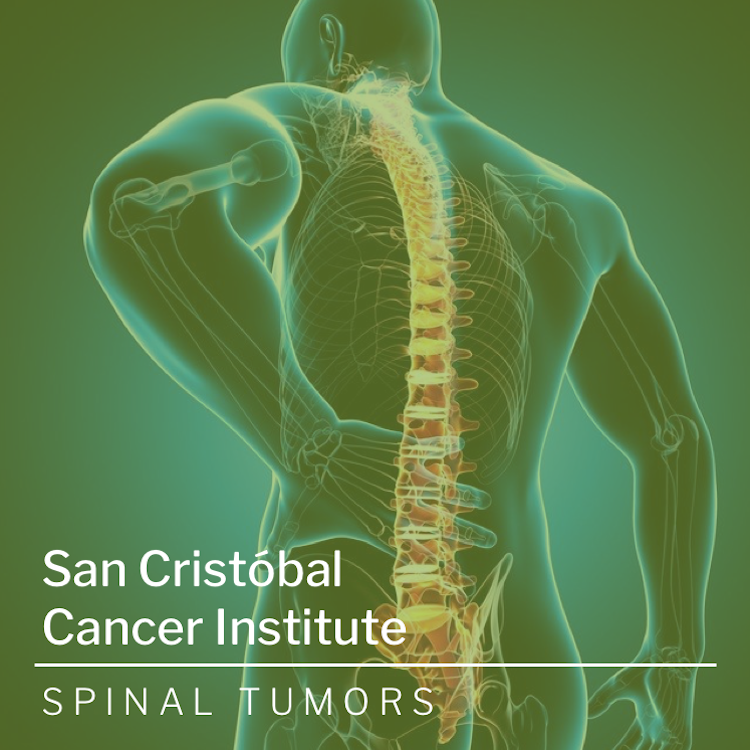
Spinal Tumors Facts

The symptoms of spinal cancer depend on several factors, including the tumor type, size, location and extent, as well as age, health history and more. Some common spinal cancer symptoms include pain, numbness, weakness and difficulty with urination. The symptoms of spinal cancer may occur very slowly. Other times, they occur quickly, even over a matter of hours or days. Metastatic spinal tumors, which have spread to the spine from another location in the body, often progress quickly.
Overview
A spinal tumor is a growth that develops within your spinal canal or within the bones of your spine. A spinal cord tumor, also called an intradural tumor, is a spinal tumor that that begins within the spinal cord or the covering of the spinal cord (dura). A tumor that affects the bones of the spine (vertebrae) is called a vertebral tumor. Spinal cord tumors may be classified as one of three different types depending on where they occur relative to the protective membranes of the spinal cord.
Tumors from other parts of the body can spread (metastasize) to the vertebrae, the supporting network around the spinal cord or, in rare cases, the spinal cord itself. Spinal tumors or growths of any kind can lead to pain, neurological problems and sometimes paralysis. A spinal tumor can be life-threatening and cause permanent disability. Treatment for a spinal tumor may include surgery, radiation therapy, chemotherapy or other medications.
Types
These are the main types of intradural tumors:
- Intramedullary tumors begin in the cells within the spinal cord itself, such as gliomas, astrocytomas or ependymomas.
- Extramedullary tumors grow in either the membrane surrounding the spinal cord or the nerve roots that reach out from the spinal cord. Although they don’t begin within the spinal cord itself, these types of tumors may affect spinal cord function by causing spinal cord compression and other problems. Examples of extramedullary tumors that can affect the spinal cord include meningiomas, neurofibromas, schwannomas and nerve sheath tumors.
Symptoms
Spinal cord tumors can cause different signs and symptoms, especially as tumors grow. The tumors may affect your spinal cord or the nerve roots, blood vessels or bones of your spine. Signs and symptoms may include:
- Pain at the site of the tumor due to tumor growth
- Back pain, often radiating to other parts of your body
- Feeling less sensitive to pain, heat and cold
- Loss of bowel or bladder function
- Difficulty walking, sometimes leading to falls
- Back pain that’s worse at night
- Loss of sensation or muscle weakness, especially in your arms or legs
- Muscle weakness , which may be mild or severe, in different parts of your body
Back pain is a common early symptom of spinal tumors. Pain may also spread beyond your back to your hips, legs, feet or arms and may worsen over time — even with treatment. There are many causes of back pain, and most back pain isn’t caused by a tumor. But because early diagnosis and treatment are important for spinal tumors, see your doctor about your back pain if:
- It’s persistent and progressive
- It’s not activity related
- It gets worse at night
- You have a history of cancer and develop new back pain
- You have other symptoms of cancer, such as nausea, vomiting or dizziness
Seek immediate medical attention if you experience:
- Progressive muscle weakness or numbness in your legs or arms
- Changes in bowel or bladder function
Diagnosis
Spinal tumors sometimes might be overlooked because they’re not common and their symptoms resemble those of more common conditions. For that reason, it’s especially important that your doctor know your complete medical history and perform both general physical and neurological exams. If your doctor suspects a spinal tumor, these tests can help confirm the diagnosis and pinpoint the tumor’s location:
- Spinal magnetic resonance imaging (MRI). MRI uses a powerful magnetic field and radio waves to produce accurate images of your spine, spinal cord and nerves. MRI is usually the preferred test to diagnose tumors of the spinal cord and surrounding tissues. A contrast agent that helps highlight certain tissues and structures may be injected into a vein in your hand or forearm during the test. Some people may feel claustrophobic inside the MRI scanner or find the loud thumping sound it makes disturbing. But you’re usually given earplugs to help with the noise, and some scanners are equipped with televisions or headphones. If you’re very anxious, ask about a mild sedative to help calm you. In certain situations, a general anesthetic may be necessary.
- Computerized tomography (CT). This test uses a narrow beam of radiation to produce detailed images of your spine. Sometimes it’s combined with an injected contrast dye to make abnormal changes in the spinal canal or spinal cord easier to see. A CT scan is only rarely used to help diagnose spinal tumors.
- Biopsy. The only way to determine the exact type of a spinal tumor is to examine a small tissue sample (biopsy) under a microscope. The biopsy results will help determine treatment options.
Treatment
Ideally, the goal of spinal tumor treatment is to eliminate the tumor completely, but this goal may be complicated by the risk of permanent damage to the spinal cord and surrounding nerves. Doctors also must take into account your age and overall health. The type of tumor and whether it arises from the structures of the spine or spinal canal or has spread to your spine from elsewhere in your body also must be considered in determining a treatment plan. Treatment options for most spinal tumors include:
- Surgery. This is often the treatment of choice for tumors that can be removed with an acceptable risk of spinal cord or nerve injury damage. Newer techniques and instruments allow neurosurgeons to reach tumors that were once considered inaccessible. The high-powered microscopes used in microsurgery make it easier to distinguish tumor from healthy tissue. Doctors also can monitor the function of the spinal cord and other important nerves during surgery, thus minimizing the chance of injuring them. In some instances, very high-frequency sound waves might be used during surgery to break up tumors and remove the fragments. Recovery from spinal surgery may take weeks or longer, depending on the procedure. You may experience a temporary loss of sensation or other complications, including bleeding and damage to nerve tissue.
- Radiation therapy. This may be used to eliminate the remnants of tumors that remain after surgery, to treat inoperable tumors or to treat those tumors where surgery is too risky. Medications may help ease some of the side effects of radiation, such as nausea and vomiting. Sometimes, your radiation therapy regimen may be adjusted to help minimize the amount of healthy tissue that’s damaged and to make the treatment more effective. Modifications may range from simply changing the dosage of radiation to using sophisticated techniques such as 3-D conformal radiation therapy.
- Chemotherapy. A standard treatment for many types of cancer, chemotherapy uses medications to destroy cancer cells or stop them from growing. Your doctor can determine whether chemotherapy might be beneficial for you, either alone or in combination with radiation therapy. Side effects may include fatigue, nausea, vomiting, increased risk of infection and hair loss.
- Other drugs. Because surgery and radiation therapy as well as tumors themselves can cause inflammation inside the spinal cord, doctors sometimes prescribe corticosteroids to reduce the swelling, either after surgery or during radiation treatments. Although corticosteroids reduce inflammation, they are usually used only for short periods to avoid serious side effects such as muscle weakness, osteoporosis, high blood pressure, diabetes and an increased susceptibility to infection.
Resources
San Cristobal Cancer Institute offers a wide array of options to help our patients feel calm and supported during the process of screening, diagnosis and treatment, as well as getting back to life after cancer. Browse our alternatives for patients – including financial aid for those eligible – in our Patient Resources section.
If you’d like to learn more about Spinal Tumors through our San Cristóbal Education Resources, attend our events or learn about our Cancer Center, please contact us.
Knowledge is Power.
Education is one of our strongest tools at San Cristóbal Cancer Institute, empowering patients and their families with complete and updated information about more than a dozen types of cancer and providing first-hand knowledge through our dedicated team of cancer experts. If you’d like to know more, please get in touch with us. We look forward to offering you and your family powerful cancer awareness and the most comprehensive care.
